
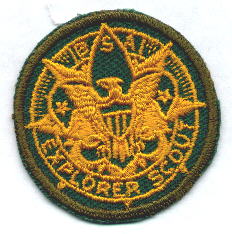 Explorer
Scouts (1933-1949)
Explorer
Scouts (1933-1949)
Overview
After several years of experimentation in the west, mainly in Utah,
Washington, and Oregon, going as far back as 1922, Explorer Scouts was
approved by the National Committee in 1933 and became one part of the Senior
Scout program in 1935. It was in many ways a kind of 'land based',
high adventure/advanced camping version of Sea Scouts. When it first
started, it was unclear the direction of the program. Initially,
they didn't have a true advancement program or distinct uniform.
Much of that came later. The early years of the program are unclear to
me. Little data exists on early standalone units for Explorer Scouts.
For example, in National statistics for Senior Scouting, there are no membership
listings for Explorer Scouts between 1933 and 1936! Explorer Scouts
first existed only within Boy Scout Troops, organized into Explorer Scout
Patrols. At first, Explorer Scout units were called Troops.
It was only later on, probably around 1944 that the term "Post" was used
for Explorer Scout units.
Then, in September of 1949, with the change in Senior Scouts, Explorer Scouts became simply Explorers.
Explorer Scout Program
The Explorer Scout program was built around the idea of advanced outdoor
activities, going beyond what a 12/13 year Boy Scout could do. This
concept is what inspired the advancement and uniform of this program.
In 1944 the program was revamped, and the disctinctive uniform and advancement was established. In some ways, it was a new Explorer Scout program.
Explorer Scout Uniforms
At first, Explorer Scouts were not given their own distinct uniform.
They wore the regular Boy Scout khaki uniform, but with a shirt strip that
read "Explorer Scout, BSA", later "Explorer Scouts, BSA" in place of the
regular "Boy Scouts of America" strip. In 1944, a distinctive uniform
for Explorer Scouts was developed. This would be a forest green uniform
that would quickly become the standard uniform of Explorers. With
this forest green uniform, brown on green unit numerals and community strips
were developed. A brown tie would be worn with the forest green uniform.
Explorers could also wear the regular khaki scout uniform with a maroon
tie (Boy Scouts did not wear ties, and adult leaders wore khaki ties).
No forest green shorts were produced, so they would wear khaki shorts with
either the khaki shirt or the forest green shirt.

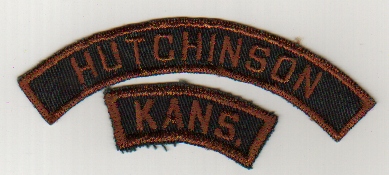

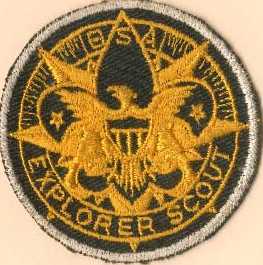
There were also a variety of collar pins and lapel pins made.
Collar pins were 7/8 in and lapel pins 5/8. There were available
in both universal versions, and for the advisors.
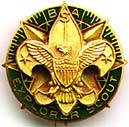 |
 |
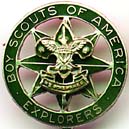 |
Advisor
lapel pin NO PICTURE |
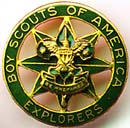 |
Assistant
Advisor lapel pin NO PICTURE |
Explorer Scout Advancement Program
Initially, the advancement program for Explorer Scouts was the Explorer
Scout Honors. Requirements can be seen here.
These Honor bars would be worn on the right sleeve below the Explorer medallion.
They could, of course, work toward Eagle Scout. And there would be
Senior
Scout Titles that they (and all other Senior Scouts) could work on.
In 1944, they would get a more distinctive advancement program like other Senior programs. Inspired by both the four level advancement programs used by Sea Scout since 1924 and Air Scouts since 1942, Explorer Scouts would also get a four level program of Apprentice, Woodsman, Frontiersman, and Ranger. The requirements are given here. This program would end when Explorer Scouts became Explorers in 1949, and this program was replaced by the new advancement program for Explorers.
Requirements for Explorer Scout Honors are HERE.
Requirements for Senior Scout Titles are HERE.
Requirements for the "Ranger" Program are HERE.
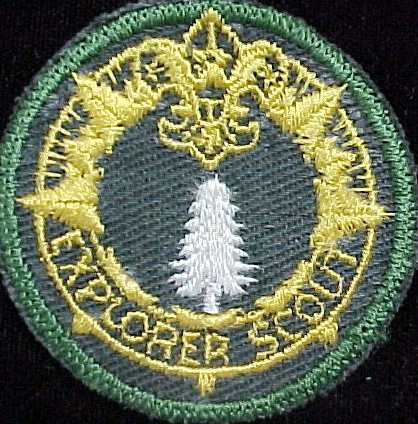 Woodsman Woodsman |
|
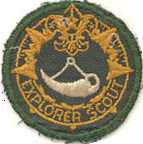 Ranger Ranger |
|
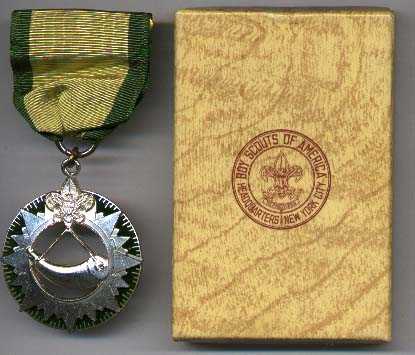 |
 Ranger
Knot Ranger
Knot |
Explorer Scout Unit Organization
It appears that initially there were no Explorer Scout Units.
They existed only as Patrols within existing Boy Scout Troops. When
Explorer Scout Units were first established, they were called Troops. It
is unclear what office insignia these Explorer Scout Troops used.
Probably regular Boy Scout office patches. Later, in 1944, units were called
Posts. These were subdivided into smaller groups first called Outposts,
then later called Crews around 1946. To better understand the terms
used in the Explorer Scout program, here is a comparison with Boy Scout
Troops and later Explorer Posts.
Explorer Patrol Leader patches were used during the early part of the
program. These patches were worn on the right sleeve below the Explorer
medallion. With the advent of Explorer Scout Posts, these were dropped.
| Boy Scout Troop | Explorer Scout Post | Explorer Post |
| Scoutmaster | Post Advisor | Post Advisor |
| Senior Patrol Leader | Post Guide | Senior Crew Leader |
| Patrol | Outpost, later Crew | Crew |
| Patrol Leader | Outpost Leader, later Crew Leader | Crew Leader |
| Scribe | Post Secretary | Post Secretary |
 Explorer
Patrol Leader with Second Honors Explorer
Patrol Leader with Second Honors |
 Advisor Advisor |
Assistant Advisor NO PICTURE |
 Post
Advisor Post
Advisor |
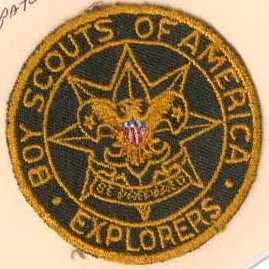 Assistant
Post Advisor Assistant
Post Advisor |
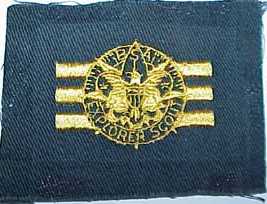 Post
Guide Post
Guide |
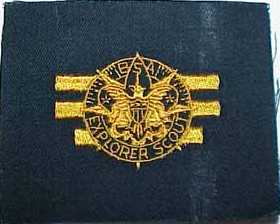 Assistant
Post Guide Assistant
Post Guide |
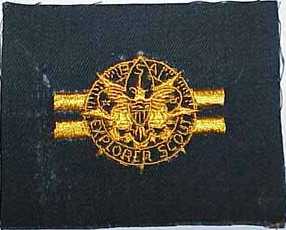 Crew
Leader Crew
Leader |
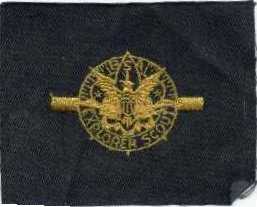 Assistant
Crew Leader Assistant
Crew Leader |
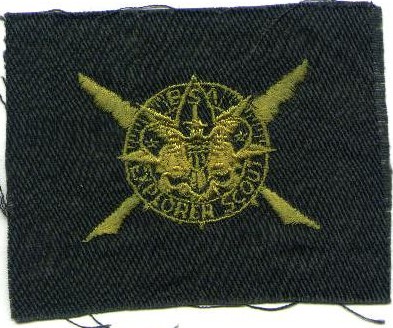 Secretary Secretary |
Literature
While the program was approved in 1933 and run as an experimental program
in years prior, the first 'official' manual for the program did not appear
until 1938!! The Guide Books to Senior Scouting that first came
out in 1935 did cover the Explorer Scout program, spending about a third
of the booklet on the program. Most likely other literature did exist before
then, but at this point this is unknown.
The first basic manual for Explorer Scouts was the Adventuring for Senior Scouts book. It gave detailed information on advanced camping and high adventure activities, as well as requirements for Senior Scout Titles and Explorer Scout Honors. It included information about the other senior scout programs, about a chapter each, but left the bulk of that to those program's manuals.
Later a new Explorer Scout Manual was created. This manual gave detailed information on how Explorer Scouts operated, and their new advancement program.
In 1943, Program Notebooks were begun. The one for Senior Scouting covered all three main programs.
The only manual for adult leaders was the generic Hints for Senior Scout Leadership. It replaced a short-lived booklet called Hints on Explorer Leadership. Why nothing equivalent to a Scoutmaster Handbook was produced is unknown.
No Nationally published newsletter or magazine existed for the Explorer
Scout program.
| The Senior Program Guide Book (#3442)
early 1935? Guide Book of Senior Scouting (#3442) 1935, Oct 1937 1938, January 3000 1941, March 3000 pamphlet, 72-76pg |
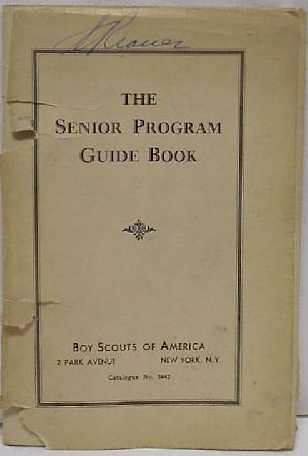 |
| Adventuring for Senior Scouts (#3639)
Proof 1938 1st 1938 693p+10p 2nd 1939, Apr 10000439 3rd 1942, May 4th 1942, Jun 692p [revised 2nd printing, cover change] 5th 1944, Jun 687p 6th 1945, Apr 687p+8p 7th 1946, Jan 686p+8p 5000146 hardback book, edited by W.H. Hurt |
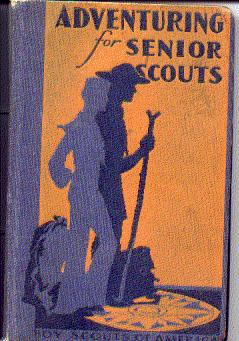 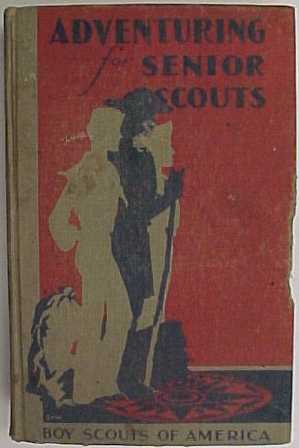 |
| Explorer Scout Manual (#3506)
1st 1946, Oct 382p+2p 50000 2nd 1947, Aug 382p 20000 paperback book, written by Carl D. Lane |
 |
| Senior Scout Program Notebook
1943 (shown) 1944 1945 (shown) 1946 (shown) 10000 1946-47 (shown) 1947-48 1948-49 (shown) 1949-50 (shown) 18000 booklet, 128pg |
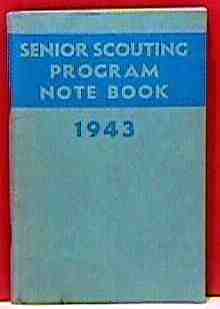  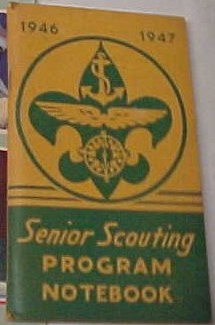 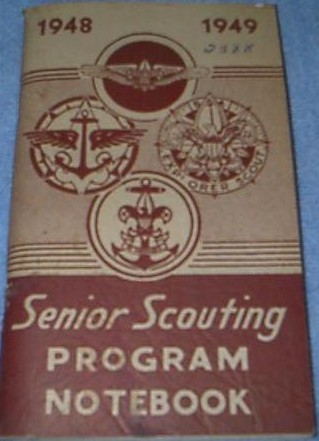 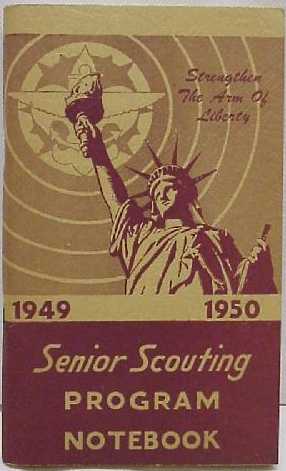 |
| Hints on Explorer Leadership
1st 1946 booklet |
 |
| Hints on Senior Scout Leadership
1st 1947 15000647 2nd 1948 3rd 1949 booklet, 94pg |
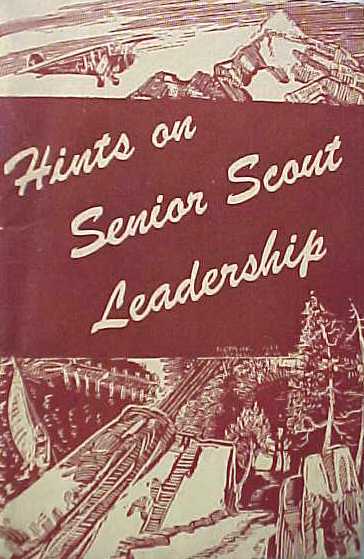 |
| year | membership | units | Ranger awards |
| 1933 | ----- | ? | -- |
| 1934 | ----- | ? | -- |
| 1935 | ----- | ? | -- |
| 1936 | ----- | ? | -- |
| 1937 | 5266 | ? | -- |
| 1938 | 10625 | ? | -- |
| 1939 | 17182 | ? | -- |
| 1940 | 22563 | ? | -- |
| 1941 | 23200 | ? | -- |
| 1942 | 20135 | ? | -- |
| 1943 | 15231 | ? | -- |
| 1944 | 16212 | ? | 0 |
| 1945 | 23125 | ? | 15 |
| 1946 | 33634 | ? | 108 |
| 1947 | 46146 | ? | 294 |
| 1948 | 51557 | ? | 458 |
| 1949 | 63594 | ? | 611 |
| 1950 | ? | 1218* | |
| 1951 | ? | 78* |
Source: BSA Annual Reports, as reported in Art Hyman's book The Scout
in Aviation.
Updated: 12/05/2002mrb